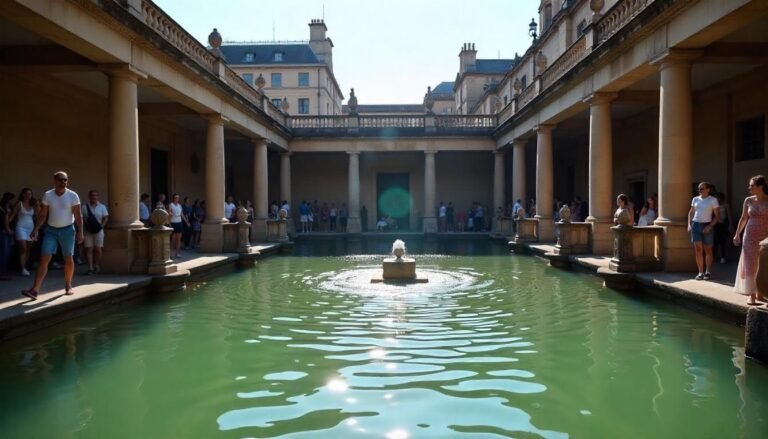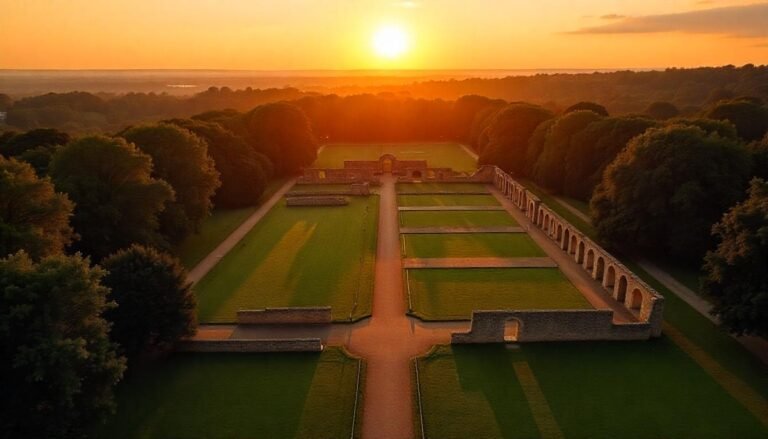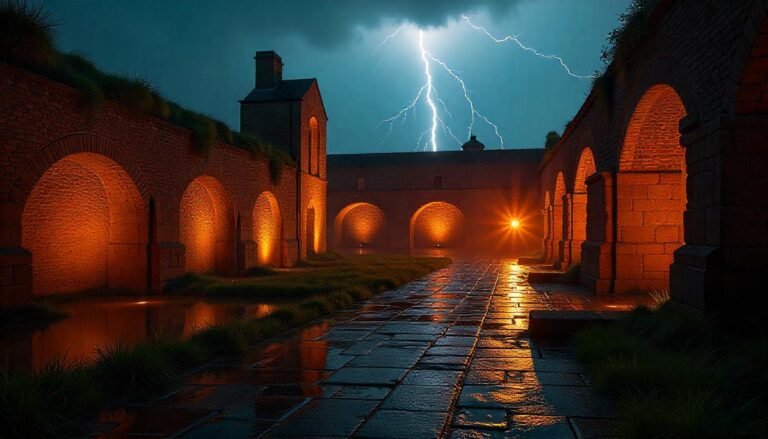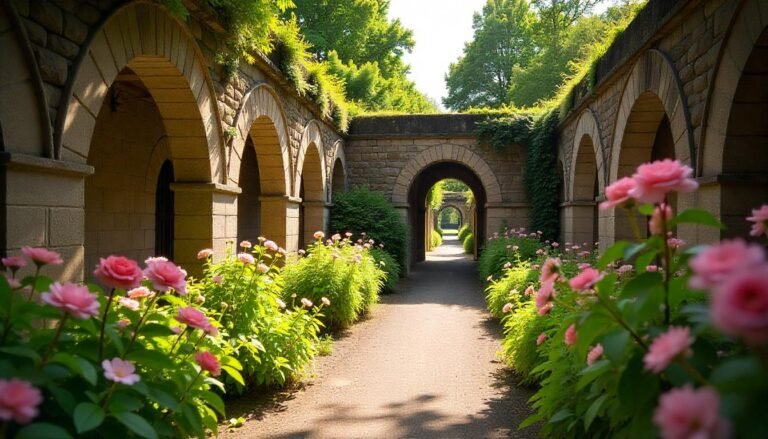Britain might be better known for castles and cathedrals, but dig a little deeper (sometimes quite literally), and you’ll uncover some astonishing Roman history. From defensive walls and bathhouses to entire Roman towns, these ruins tell the story of an empire that forever changed Britain’s landscape. If you’re a history lover, archaeologist at heart, or just fancy walking in the footsteps of centurions, here are 12 must-visit Roman ruins in Britain for 2025 that will transport you back nearly 2,000 ye
1. Hadrian’s Wall – Northumberland & Cumbria

No list of Roman ruins in Britain would be complete without Hadrian’s Wall. Stretching 73 miles coast to coast, this mighty stone fortification once marked the northern edge of the Roman Empire.
Built on the orders of Emperor Hadrian in AD 122, the wall was more than just a barrier—it was a complex military zone with forts, milecastles, watchtowers, and settlements. Today, large portions of it still stand, and many of its forts are open to the public.
Top sites to explore:
Housesteads Roman Fort – One of the best-preserved forts, with an on-site museum and panoramic views.
Chesters Roman Fort & Museum – Features preserved bathhouses and a collection of Roman artefacts.
- Travel Tip: Walk part of the Hadrian’s Wall Path National Trail for a scenic and immersive experience.
- Visit English Heritage – Hadrian’s Wall
2. Roman Baths – Bath, Somerset

Elegant and atmospheric, the Roman Baths in the city of Bath are among the finest ancient Roman remains in northern Europe. Built around 70 AD, these baths were a key part of Roman social and religious life, drawing visitors to the natural hot springs for healing and ritual.
Although you can’t bathe in the original Roman pools, you can tour the complex, see the ruins, and even sip the mineral-rich spring water (if you dare).
- Don’t miss: The Great Bath, the temple courtyard, and the live projections of Roman citizens on the ancient walls—it brings history to life in the most vivid way.
- Explore the Roman Baths Official Website
3. Fishbourne Roman Palace – West Sussex

Discovered by accident in the 1960s, Fishbourne Roman Palace is the largest Roman residence north of the Alps—and it’s astonishingly grand.
Dating to around AD 75, it likely belonged to a powerful local ruler allied with Rome. The site boasts intricate mosaic floors, formal gardens, and a glimpse into Roman luxury.
What sets Fishbourne apart is how modern it feels, with central heating systems, spacious rooms, and symmetrical design that rivals Roman villas in Italy.
- Must-see: The Cupid on a Dolphin mosaic and the recreated Roman gardens.
- Visit Fishbourne Roman Palace
4. Verulamium – St Albans, Hertfordshire

Verulamium was once the third-largest city in Roman Britain, and although most of it now lies beneath modern St Albans, key remains have been preserved and are open to the public.
You’ll find a well-preserved Roman theatre, mosaic floors, and a fantastic museum housing everyday Roman artefacts—pottery, coins, tools—that provide insight into urban life in Britain under Rome.
The parkland setting makes it ideal for a day out with the family.
- Nearby: Don’t miss St Albans Cathedral, which has reused Roman materials in its construction.
- Verulamium Museum – St Albans City & District
5. Caerleon Roman Fortress & Baths – Newport, Wales

If you’re venturing into South Wales, Caerleon is an underrated gem. This Roman fortress (Isca Augusta) was one of only three permanent legionary bases in Britain.
Here, you’ll find an impressive amphitheatre, barracks, and well-preserved bathhouse, giving you a vivid picture of military life in Roman Britain.
According to legend, Caerleon was also linked to King Arthur’s Camelot, adding an extra layer of myth to your visit.
- Good to know: Entry is free, and the nearby National Roman Legion Museum is full of hands-on exhibits for kids and adults alike.
- Discover Caerleon at National Museum Wales
6. Roman Amphitheatre – Chester, Cheshire

Chester’s Roman Amphitheatre is the largest known amphitheatre in Britain, once seating up to 8,000 spectators. It was primarily used for gladiator combat and military training, offering insight into Roman entertainment and discipline.
Only half the site has been fully excavated, but even so, the scale is impressive. Located right in the heart of Chester, it’s easy to combine a visit with exploring the city’s Roman walls and heritage trail.
- Why go: You can stand in the centre of the arena where Roman soldiers once trained and fought.
- Visit Chester Roman Amphitheatre
7. Wroxeter Roman City – Shropshire

Known as Viroconium, Wroxeter was once the fourth-largest city in Roman Britain. What makes this site remarkable is how much of the original urban layout remains.
Here, you can explore the Old Baths complex, a reconstructed Roman townhouse, and ruins that still hint at the city’s former importance.
- Top feature: The recreated Roman home built using ancient methods—it’s like stepping into a living museum.
- Explore Wroxeter Roman City
8. London Mithraeum – London

Hidden beneath the Bloomberg offices in the City of London lies the London Mithraeum, a reconstructed Roman temple dedicated to Mithras, a mysterious god worshipped by Roman soldiers.
Discovered in the 1950s and relocated in 2017, it’s now one of the capital’s most atmospheric ancient sites. The immersive light and sound experience during your visit makes it feel almost like a Roman ritual is still taking place.
- Don’t miss: The glass gallery of Roman artefacts found during the excavation—including shoes, writing tablets, and even a curse tablet.
- Visit London Mithraeum Bloomberg SPACE
9. Richborough Roman Fort – Kent

Often called the “gateway to Roman Britain”, Richborough (Rutupiae) is believed to be the landing point of the Roman invasion in AD 43. It later became a significant port and defensive site.
You can still see the massive stone walls, remnants of an amphitheatre, and foundations of several Roman buildings. The site’s peaceful countryside setting contrasts with its dramatic military history.
- Fun fact: A huge triumphal arch once stood here, marking the power of Rome to all who arrived.
- Discover Richborough Roman Fort
10. Lunt Roman Fort – Baginton, Warwickshire

Lunt Fort is one of Britain’s most interactive Roman sites—perfect for families or those wanting to see reconstructed Roman military buildings up close.
Excavated in the 1960s, the site has been partially rebuilt to show what a working Roman fort would have looked like, complete with a gyrus (circular training ring)—the only one of its kind found in the Roman Empire.
- Why visit: You can walk through reconstructed gates, granaries, and even see how Roman soldiers trained their cavalry.
11. Vindolanda – Northumberland

Just south of Hadrian’s Wall, Vindolanda is one of Britain’s most important Roman archaeological sites. What sets it apart is the ongoing excavations—you might literally see archaeologists at work uncovering history right in front of you.
Vindolanda was a Roman auxiliary fort that housed soldiers and their families. Thousands of artefacts have been discovered here, including the Vindolanda Tablets—thin wooden writing tablets that give us personal letters, shopping lists, and even military reports from nearly 2,000 years ago.
What to explore:
Stone foundations of barracks, bathhouses, and homes.
On-site museum with Roman boots, jewellery, and preserved letters.
Real-time digs (running through summer 2025).
- Visit Vindolanda – Official Website
12. Arbeia Roman Fort – South Shields, Tyne & Wear

Overlooking the River Tyne, Arbeia was a key Roman supply base that once stored grain, oil, and wine for the legions along Hadrian’s Wall. Today, it features impressive reconstructed buildings including the West Gate, barracks, and a commanding officer’s house.
This site is especially useful for understanding how Roman forts operated, and it’s one of the best spots in the UK for seeing full-size Roman architecture rebuilt to scale.
Good to know:
Free admission.
Family-friendly with Roman-themed events and kids’ activities throughout 2025.
- Discover Arbeia Roman Fort
Tips for Visiting Roman Ruins in Britain in 2025
Book in advance: Sites like Bath and Fishbourne are popular—booking tickets ahead ensures a smooth trip.
Layer up: Some ruins are exposed and best enjoyed on foot, so pack waterproofs and comfy shoes.
Join a guided tour: Many sites offer local experts or audio guides to bring the ruins to life.
Check for events: Several locations host Roman re-enactments, family days, and archaeology festivals in summer 2025.
Final Thoughts
Whether you’re gazing at mosaics in Sussex or standing atop Hadrian’s Wall, these Roman ruins offer more than just crumbling stones—they offer a portal into a lost empire. Visiting these historic sites in 2025 is not only educational but a deeply enriching travel experience.
If you’re crafting your UK travel itinerary, be sure to add at least one of these Roman gems—you’ll walk away with a greater appreciation of Britain’s layered past.
FAQs – Roman Ruins in Britain 2025
1. What is the most famous Roman ruin in Britain?
Hadrian’s Wall is the most iconic, stretching across northern England with forts, milecastles, and walking trails.
2. Can you still visit Roman baths in the UK?
Yes, the Roman Baths in Bath are open to visitors, offering a museum and views of the original Great Bath.
3. Are any Roman sites free to visit?
Yes. Sites like Caerleon Roman Fortress and Arbeia Roman Fort offer free entry with museums and reconstructions.
4. What’s the best Roman site for families?
Lunt Roman Fort and Vindolanda are great for families, with reconstructions and interactive exhibits.
5. When is the best time to visit Roman ruins in the UK?
Late spring to early autumn (May–September) offers mild weather and live re-enactments at many sites.




